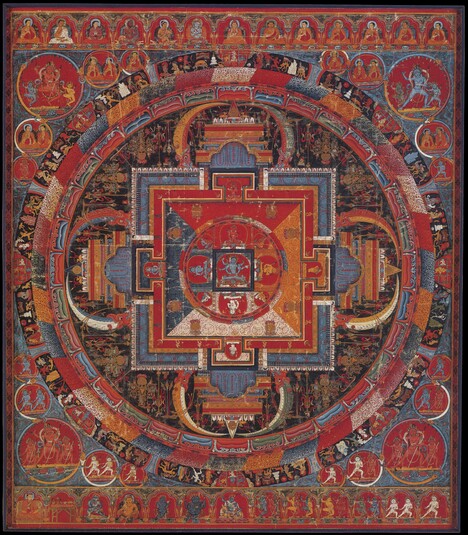
Item: Mandala of Jnana Dakini (Buddhist Deity) - (Three Faces, Six Arms)
| Origin Location | Tibet |
|---|---|
| Date Range | 1300 - 1399 |
| Lineages | Sakya and Buddhist |
| Material | Ground Mineral Pigment on Cotton |
| Collection | The Metropolitan Museum of Art |
Jnana Dakini Thirteen Deity Mandala. A set of forty-two mandalas, as described in the Vajravali Sanskrit text of Abhayakaragupta, commissioned in honour of Lama Dampa Sonam Gyaltsen.
"Seated above a lion, variously [coloured] lotus and moon seat is Jnana Dakini, blue [in colour], with three faces, blue, white and red, and six arms. Each face has three eyes. The right three hands hold a katvanga staff, axe and vajra scepter. The right three [hands] hold a bell, blood filled skullcup and a sword. Adorned with a skull garland and the five mudras, [she] is seated in sattva posture in the middle of a fiercely blazing mass of pristine awareness fire." (bod brgyud nang bstan lha tshogs chen mo bshugs so, page 388).
The meditational deity Jnana Dakini arises from the Chaturpita Tantra (catuhpitha-mahayoginitantraraja-nama) and is typically found in a thirteen deity mandala configuration. The principal deity of the tantra is Yogambara. (See TBRC w25336, w25337, w25338).
Jeff Watt 7-2009

Exhibition: Mandala, The Perfect Circle (RMA)
Publications
Publication: Sacred Visions
Thematic Sets
Collection of The Metropolitan Museum of Art: Main Page
Buddhist Deity: Jnana Dakini (Masterworks)
Painting: Styles of Painting
Painting Set: Vajravali (Lama Dampa Set)
Subject: Vajravali Main Page
Mandalas: Cemeteries on the Outside
Mandala: Sakya (Outside Cemetery Configuration)
Exhibition: Mandalas, Mapping the Buddhist Art of Tibet (Mandalas)
Buddhist Deity: Jnana Dakini Main Page
